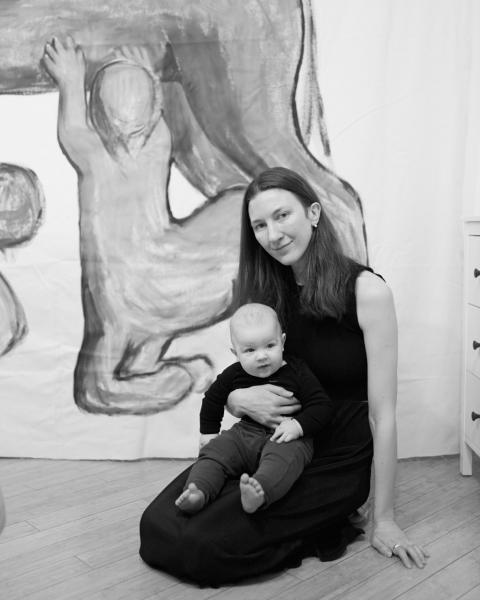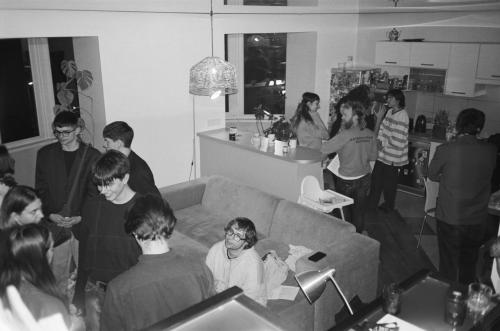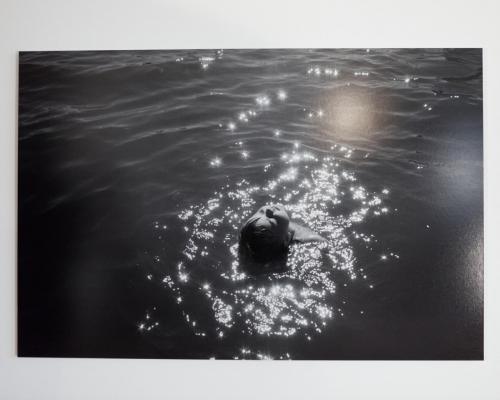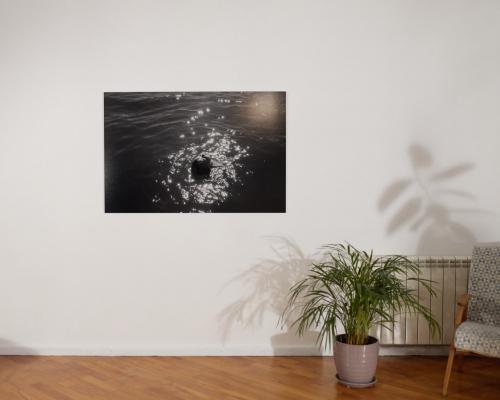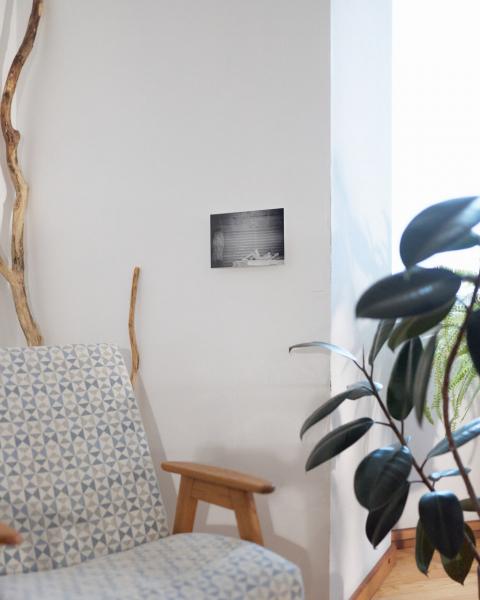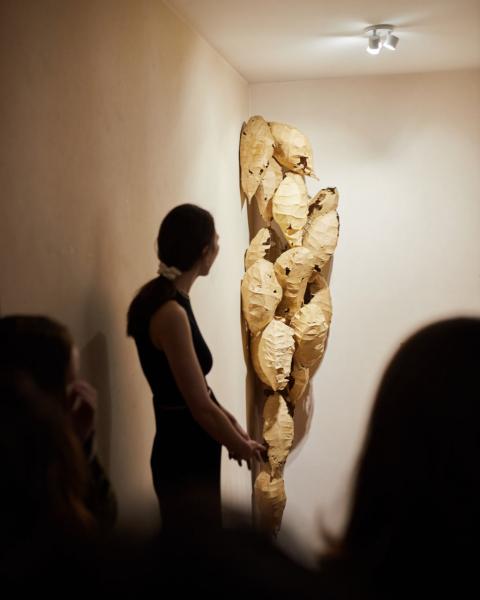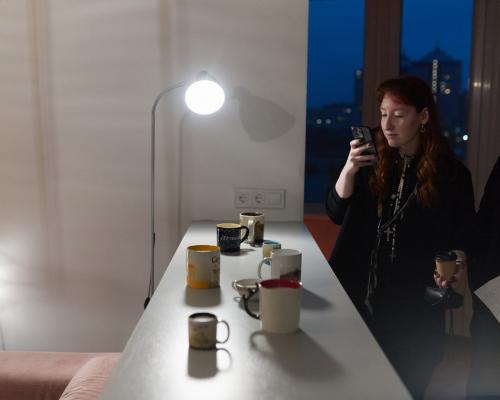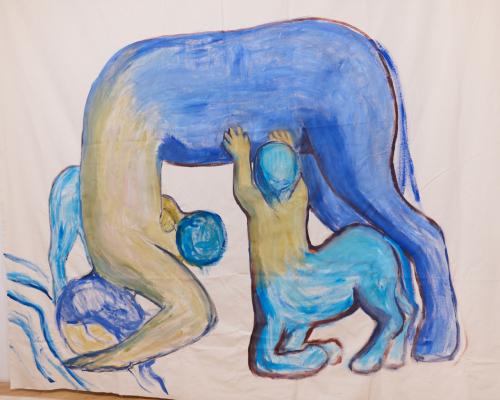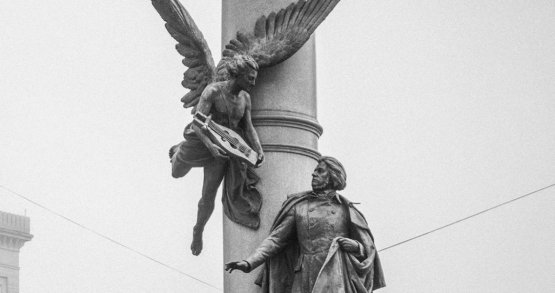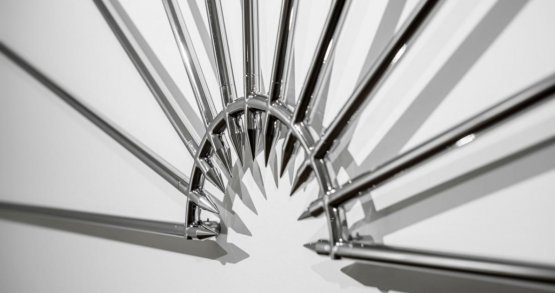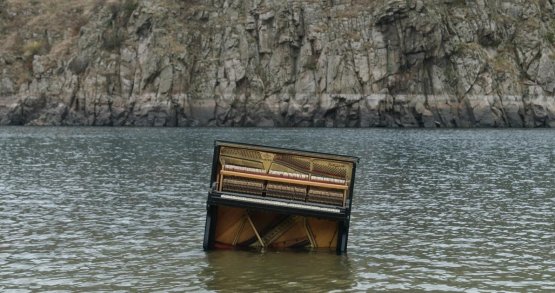Teo, a baby who recently turned 7 months old, is sitting in the arms of Dmytro, a curator and also his father, and next to him is Sasha, the curator of the apartment exhibition Milk for Teo, dedicated to Sasha's experience of motherhood. Before I can finish my first question, Teo gets cranky and Sasha takes him to play on the carpet with the artists Tamara Turliun and Lada Verbina. We are left alone with Dmytro, who invited me to write a text about their apartment exhibition.
Oleksandra Pogrebnyak and Dmytro Chepurnyi on apartment exhibitions, curating with a baby, and stories against the backdrop of war
Dmytro Chepurnyi: Last year, when Sasha organized her first apartment exhibition, "Thickets, Groves, Woods and Bushes," I was also involved. She used some of my text in the title and in captions, and I lived in that space too. For example, if the kitchen stove doesn't work because there's an installation by Zhanna Kadyrova, I'm not eating. I mean, of course, when I comment on our shows, I have to point out that I am also the technical director, the production guy, and the person who hangs everything on nails. When we first organized the exhibition, of course we thought about the documentation. We had a situation with an American art magazine that pointed out that the material they were offered was written by someone directly involved in the exhibition. I didn't write a review of the exhibition, just a piece without an opinion, but they didn't publish it. This is a universal journalistic ethic - you can't write about your wife's exhibition. However, in Ukraine, you can put a lot of asterisks on this rule. For example, last year's exhibition occurred during a blackout, when people were leaving cities where the electricity was cut off. Another problem with the exhibition documentation is that our apartment is not an institution or even an artist-run space, we don't have a website, so the visibility of the exhibition depends only on mentions in the media.
Oleksandra joins us, leaving the baby with the artists.
Alya Segal: This is the second year you've organized the apartment shows, and they have a wide reach. At the opening I saw both my artist friends and, for example, the art director of PincukArtCenter, Björn Geldhof, with a group of people in business suits. To what extent do you see your space as a gallery? Or are these still separate apartment exhibitions?
Oleksandra Pogrebnyak: The connection to the place and my experience working in an art center is important. Usually, you have to spend many hours in the space to understand how your exhibition solutions can work. When I made "Thickets, Groves, Woods and Bushes," an exhibition of 18 works by Ukrainian and foreign artists, I easily found a suitable place for the works. Simply because I can feel the space of the house where I have lived for many years. This year I approached the exhibition differently, mainly because I didn't want to use the previous techniques. Because of the smaller number of participants in this exhibition, almost all the works are key. Last year, the main space was the Black Box. And now it is White Cube.
Oleksandra Pogrebnyak: I haven't gotten to the walls yet.
Dmytro Chepurnyi: Sasha takes her work very seriously. Few people will prepare an apartment exhibition for six months or paint all the walls for the sake of exhibiting one work... Besides, I think the most important thing for an artist is to get feedback on their practice. To show current work, even in an unfinished form. In this case, an apartment exhibition is often not much different from a studio visit. For Sasha, as a curator, it's not so much about an apartment party and feedback as it is about a curatorial statement.
Oleksandra Pogrebnyak: At the opening, I was asked if I considered an apartment exhibition a laboratory format. My approach is different because it is shaped by my experience of working in institutions. In particular, when I start working, I try to stick to a certain timeline, which is common for my work with international artists. I know that if I don't write to the artists in October or November at the latest, 3-4 months in advance, I will hardly be able to include their works in the exhibition in February. This is especially difficult when working with a gallery.
Alya Segal: You told me that you wanted to cooperate with the artist estate and exhibit the work of an author who is no longer alive.
Oleksandra Pogrebnyak: This year, I needed a video by a Cuban artist to reinforce my reflections on the search for utopia in nature and the attempts to find refuge in the landscape. I used all my diplomatic skills. Unfortunately, the New York gallery in charge of her legacy and the inability to contact the artist directly made her participation impossible.
Alya Segal: In your curatorial tours, you start your story with the works of Kateryna Lesiv. Can you tell us about the photographs presented here?
Oleksandra Pogrebnyak: For me, this photograph of Rada [Kateryna Lesiv's daughter — ed.] swimming in a pond as if in milk, as I interpret it, is one of the first works I thought about when I started working on the exhibition. It was important for me to talk about my experience, but not about the traumatic aspects of motherhood, but rather about my observations. I had an easy pregnancy. The six months after Teo's birth were also very harmonious. Of course, motherhood, especially when combined with work, is difficult, but at the same time, it brings a feeling of boundless happiness. And in some moments, when I am exhausted, there is Teo who brings me back to life.
Oleksandra Pogrebnyak: Actually, the first thing I like to say when people ask me how the opening went is that Teo was happy. Within a few days, we managed to create a happy utopia in this apartment. It unfolds within the framework of this exhibition, within these shared experiences - this is especially the safe space that artists create. Like "Milk for Rada" or the feeding in Kateryna Lisovenko's "Drinking" or Laure Prouvost movie about the fascinating world of a little girl. These are the islands we have to build for ourselves, both in everyday life and in wartime, when terrible things happen. Partly, I create the exhibition so that Teo can refer to this experience later. It's like a photo album to capture a moment of our shared and personal experience.
Alya Segal: When I looked through Katia Lesiv's social media, including her Instagram page, I saw a lot of photos of her child. And at the same time, these photos (of course, since Katia is an artist) are quite artistic. And it's interesting how her motherhood mixes with her art, her role as a mother and an artist. Do you feel something similar in your curatorial and maternal "practice"?
Oleksandra Pogrebnyak: I think Katya relates to the world with a certain sensitivity. In fact, this sensitivity is also reflected in her everyday experiences, such as her project "I love you" with two peonies that bloom at different times. And a long series that captures her motherhood. I like that Katya leaves room for interpretation in her work. The choice of these two works was my suggestion to her. I immediately felt that the photograph of the pond should be large and central to the exhibition. However, it was her decision to hide another photograph behind the chair between the plants, a portrait of them together feeding. The second photograph reveals a narrative that is important to me, about the breast, about feeding as a physiological process. The idea is that the breast, as a woman's organ, belongs to her child. This is the central line of the exhibition, which is presented very pointedly. To notice it, you must either listen to a curatorial tour or pay attention to the details. Only when you get very close can you see this look, this little Rada clutching her breast like a predator. But at the same time, she is very agentic. Katya is as present here as her daughter.
As for my experience, it is very important that Teo lives this with me. Teo has actively participated in exhibitions since the first months of his life. He is part of the artistic process.
Oleksandra Pogrebnyak: This is what I mean by inclusivity. When we were little, our world was very small. We had our mom, dad, and family. And, for example, the neighborhood kids. I love that Teo is now meeting fantastically interesting people. It took us years to get to know everyone and start communicating and working closely with them. I am sure that he can learn something from everyone. And this environment, which I am sincerely fascinated by, this world, is already Teo's world. Everyone is also very open to him. For example, they will take it easy if Teo burps milk somewhere in the exhibition space.
Alya Segal: Among other things, you can leave your child for "visitors" and make a tour. I also wanted to talk about this little photo of a breastfeeding mother. On the tours and in the curatorial text, you say that from the moment a child is born, the breast is perceived more as an organ that no longer fully belongs to you and that has a utilitarian function. At the same time, in our culture, women's breasts are highly objectified and usually perceived as sexual objects. Please tell us how your perception of your own sexuality has changed from the role of a young woman to that of a mother.
Oleksandra Pogrebnyak: In fact, that's why there are no traumatic stories in the exhibition. I felt good when I was pregnant. During this period, a woman's body has a lot of hormones that make you look great and feel great. All nine months were (with the exception of maybe one month in the first trimester, with blackouts and toxicosis) very harmonious. I could see that my body was transforming, but it was happening so slowly that I had time to build a new relationship with it.
Everything changes with the birth of a child. Time stops being slow, everything becomes very fast, and you don't have time to think about yourself anymore. I didn't lose my body, and my relationship with it may have even become a little more harmonious.
Alya Segal: Dmytro, can you speak a little about your experience?
Dmytro Chepurnyi: Parenthood is hard. We should give a three-year vacation to everyone who gives birth to children (laughs).
Tamara Turliun: Medals and certificates of achievement are also desirable.
Dmytro Chepurnyi: You need to "sign" a new agreement in your relationship, to re-establish everything, because life changes dramatically. The baby's mother wakes up many times at night to feed the child. The baby sometimes does not let you sleep. You have less time for everything. Although at the end of the day, despite being tired, you feel that your life is more meaningful.
My understanding of femininity has also changed. I participated in a partnered birth. When Sasha was pregnant and gave birth to Theodor, I was coordinating a feminist project at the Goethe Institute. I talked a lot with Sasha about this experience, and she indirectly summarized these conversations in a curated text about milk.
Alya Segal: “Kuratorskyi Posibnyk” [the Curatorial Guide — ed.] you created with Kateryna Yakovlenko, among other things, refers to an exhibition about the problematic aspects of motherhood, about the precariousness of this experience, so this topic has already been raised in our context.
Oleksandra Pogrebnyak: Yes. This is Oksana Bryukhovetska's 2015 exhibition at the Center for Visual Culture. I think that in these nine years, we have built a different society. We live in different times and have different access to resources. The news of my pregnancy was well received at work. They tried to create comfortable conditions for me. I could take a long maternity leave or not take it at all. In the end, my vacation lasted only one month.
Oleksandra Pogrebnyak: It is important to note that these are not the works of an artist, but the drawings of a child who does not identify herself professionally, and we are exhibiting these works in a coordinated way and in dialogue with both Anya and Zoya. We are telling a story about the relationship between mother and child and the connection between different generations of artists. Anya comes from an artistic family and often references this in her practice. In particular, it is "Sculptures of My Father" from 2013, which was part of my previous apartment exhibition. Later, in 2019-2022, she created an omage dedicated to her grandfather, who was a famous painter. Zoya, if she chooses to be an artist, will also have some connection to this family heritage and the generations that have worked in this profession before her.
Children's drawings are often interesting only to parents. The drawings we selected for this exhibition were used as stencils for silk screen printing. Then T-shirts and bags with these images were sold in favor of the Ukrainian Armed Forces.
In one of the drawings, Zoya depicts the war as she saw it from a distance while she was in another country. Now she and her mother are back home, but in these drawings, Zoya imagines what the destruction looks like. At the same time, Anya also begins to draw from her imagination: people hiding from explosions, branches of destroyed trees, and dangerous lawns.
Alya Segal: There are also works by Zhanna Kadyrova on this floor. It is very interesting that this series is definitely Zhanna's work because of the use of tiles, but unlike her usual monumental size, these are very small objects.
Oleksandra Pogrebnyak: This is a very playful series that Zhanna started in 2006. In her recognizable technique, she fills various surfaces with tiles, particularly in the street environment. This work is constantly adapting to the context. At the opening of one of her exhibitions, she filled wine glasses. For "Milk for Teo" Zhanna created an installation using our dishes and filled cups and pots with milk. I like to talk about this work as the material presence of milk everywhere, milk as a liquid that fills everything in the life of a family with a child.
Oleksandra Pogrebnyak: I would like to raise more questions with this work than to answer anything. When you look at these cocoons, you don't know what kind of animal or insect created them. Through this work, I want to talk about the transformations that are happening everywhere, which are part of the world around us. And in the curatorial text, I talk about transformation as part of natural cycles or natural processes. This state of transition into something else is always with us, and it is part of motherhood, part of the world around us.
Alya Segal: Was this work from the series “Pollinator House” created specifically for this exhibition?
Tamara Turliun: This series was first presented at The Naked Room. But I really like how “Pollinator House” adapted to this space. The installation opened up beautifully in this five-meter space above the stairs.
Alya Segal: I heard a lot about how difficult the process of installing this work was.
Dmytro Chepurnyi: Three people: Vita Kotyk, Mykyta Babkin, and Tamara Turliun, held the ladder, and I stood on the last step, pressing myself against the wall like a climber. From above, we hammered in a big nail, and that's what holds everything together. This is also very much about this community support system, when a large number of people contribute to the project.
Tamara Turliun: I completely agree with Dima. One nail that holds the whole installation is a very difficult installation. It didn't work out the first time, parts of the work fell off. But I really like how this work is revealed here, how Sasha interprets it. I now also look at this work through the prism of Sasha's comments.
Alya Segal: Can you explain?
Tamara Turliun: I look at nature a lot. Sometimes I see abandoned wasp houses, and this work is something like that. When I did this series before the full invasion, it was about sensitivity, love and relationships. I was working a lot with text at the time. In the story that accompanied the exhibition, there was an unattractive fly man who was born of great love. A fairy tale character who is supposed to live in these cocoons. In this story he meets the Amorphophalus flower. This flower exists in reality, it blooms once every 10 years, looks like a phallus and has a terrible smell. But since the Fly Man is a scavenger, he is attracted to the smell. They find each other and fall in love. Sasha talks about cocoons in the context of transformation. Including the transformation of the body, but also as a natural process. I have no such experience, but lately I have been thinking more and more about motherhood.
At the same moment, Tamara receives a message from her partner: "Where are you?"
Tamara Turliun: On my way…
Alya Segal: By the way, do I understand correctly that your partner is a co-author of this work?
Tamara Turliun: Yes, he is a co-author. He created the metal frame here. He is a co-author in a lot of my works, and I try to sign him everywhere as much as possible.
Dmytro Chepurnyi: The co-author's name is Andrii Liashchuk.
Tamara gets dressed and runs to her beloved Andrii Liashchuk, while we continue our conversation. There are two more works ahead. In the children's room, the windows are covered with a huge work, "Drinking" by Kateryna Lisovenko.
Oleksandra Pogrebnyak: Katya is an artist with an active political position, but for "Milk for Teo" she creates a utopia. Her work with simultaneous feeding and drinking is to some extent escapism, an alternative to our life today. To what extent is this escapism acceptable in a country at war? Do we have to live the war every day as intensely as the previous day? Can we afford a space where we can hide with our child and milk? For me, motherhood at certain moments becomes this safe territory, this utopia, in which you can feel protected at least for some moments of time. This is also one of the lines of this exhibition: is it possible to dissolve in motherhood?
Alya Segal: In the context of this work, it was very interesting to me that you placed it as a curtain, that is, you actually separate this inner world of your apartment from the outside world, where the war and all its consequences still exist.
Oleksandra Pogrebnyak: It is also a fence from the world, but at the same time, this work works interestingly during the day when light passes through the canvas. The light gives the work presence and shows us its underside, its texture, like a painted painting. This is an additional part of the work we discussed with Katya. Of course, when you exhibit a painting, you think about creating the most gallery-like conditions for its perception. But these gaps also add an important effect.
Alya Segal: You talked about the contrast between the real and the fictional world and about utopia. This theme continues in the last work of the exhibition, "Shadow Does," by the French artist Laure Prouvost. It is also exhibited on the curtain but in your room.
Oleksandra Pogrebnyak: Here the girl talks about the world around her. It is not perfect, but it is her world. This is a work about antagonisms and the question of what is normal, because for a little girl this is the normal world, the world she knows, the world that surrounds her and that she has known since birth.
Alya Segal: This is the only work by a non-Ukrainian artist. Please tell us how you found it.
Oleksandra Pogrebnyak: Last year I worked with international artists: my friends or good acquaintances. With them it was easy, although I also contacted them 3-4 months in advance, according to the rules of the world. And this year I contacted Laure Prouvost, I didn't know her personally, but I saw her work at the 2019 Venice Biennale. She was representing the French pavilion, curated by Martha Kirszenbaum. When the full-scale war began, there was a certain period of time when everything froze, we did not rule out the possibility of a complete encirclement of Kyiv, we communicated very intensively outside. We wrote letters to international colleagues and institutions, describing our experiences: we could hear explosions from all sides, we knew that the Russian army had entered the suburbs. Dozens of such letters were sent, perhaps hundreds. I wrote one of them to Martha Kirszenbaum. She started posting our stories on Instagram, and soon she invited us to co-curate a film program for Liste in Basel, which she had to curate herself.
Sometimes I think about the number of circumstances: a full-scale war started on my birthday; I'm in Ukraine, we didn't leave because of the plants; a shell hit my grandparents' house, and we had to rebuild it; even the fact that we got married on the 17th day of the war, that we have a child now and this experience of motherhood. At some point, it seems that there are so many layers that it is hard to believe that this is a life, a life during the war. And it seems to me that a lot of people respond to these stories. Everything is not so monotonous here: destruction, losses, destruction, losses... This is what surrounds us, of course, but at the same time, I try to highlight these stories in this exhibition and in the previous one. "Thickets, Groves, Woods and Bushes" was largely about the stories we share with the outside world.
A girl tells her grandmother about the world that has changed. Her story intertwines the achievements and losses of humanity.
Alya Segal: During the tour you say that motherhood has given you the opportunity to plan. It seems that Laure's work and the exhibition in general are a kind of therapy for accepting reality as it is, with all its horrors and joys.
Oleksandra Pogrebnyak: Yes, this exhibition is necessary for me to accept the world we live in. To accept that Teo will have to face the consequences of this war when he grows up. But a child does not know any other world. I was born at a time when Ukraine had already become independent. That childhood, in which I had a sense of security, still seems to give me a sense of the possibility of a safe environment. And now we are becoming that safe environment for Teo.
To read more articles about contemporary art please support Artslooker on Patreon
Share:
